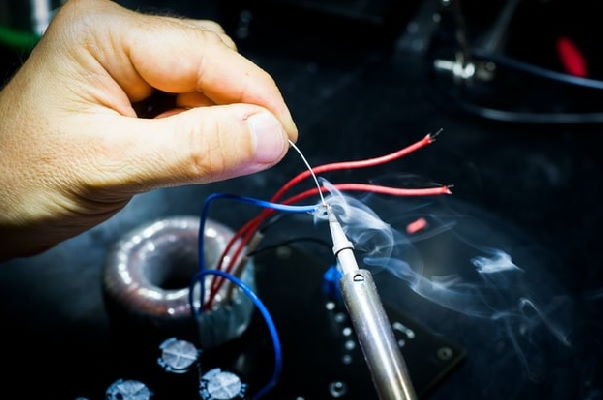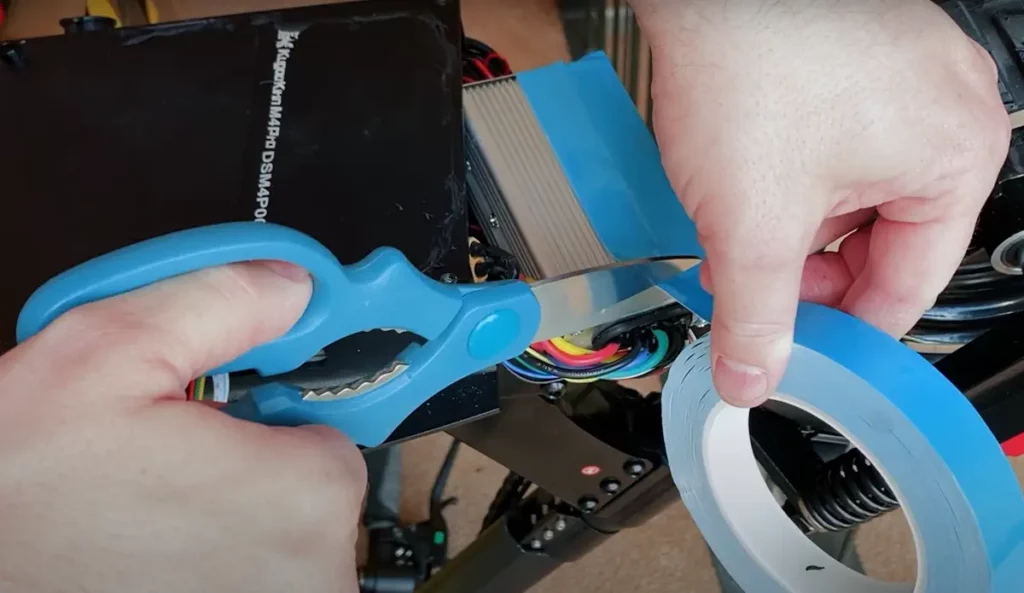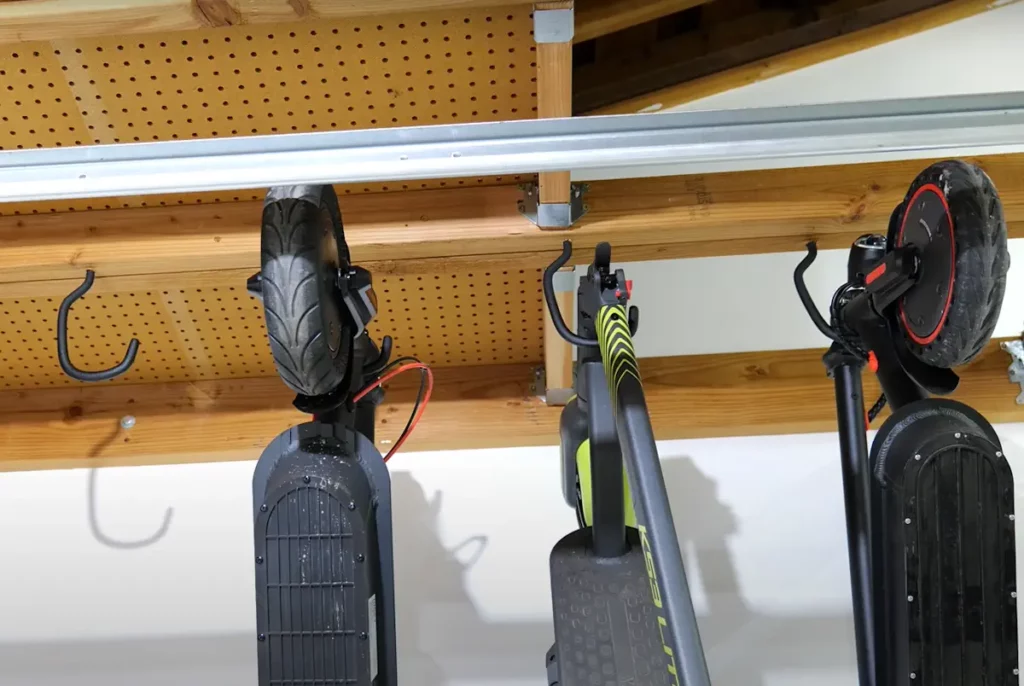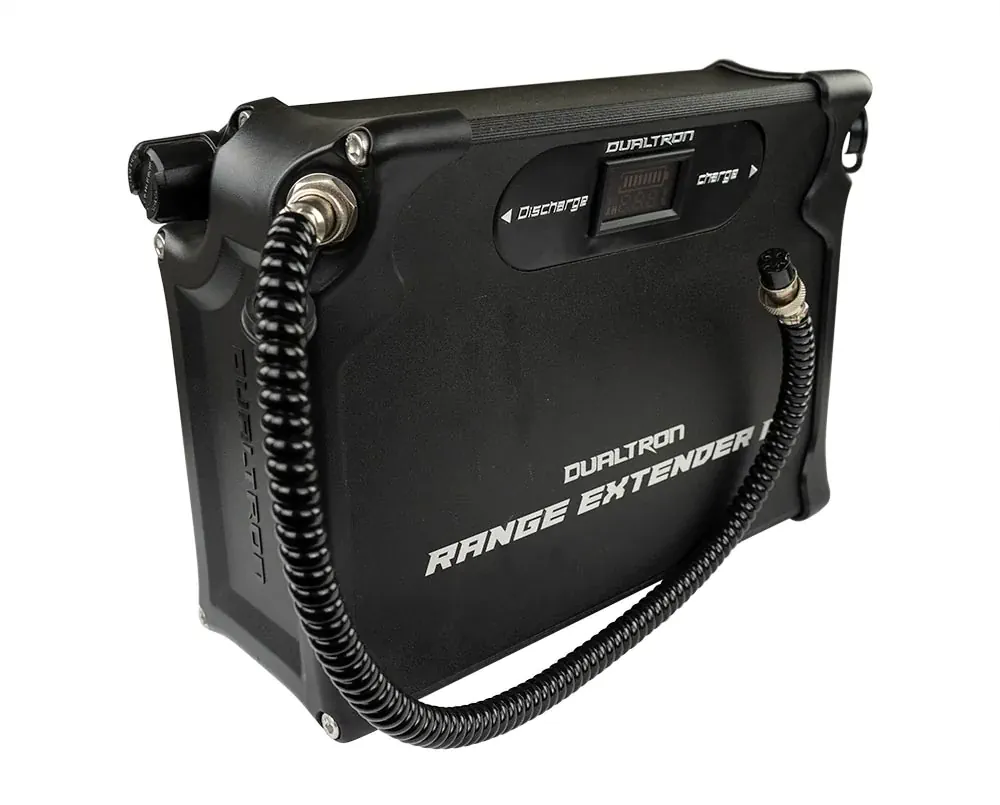If you want to travel with your scooter, the first thing that will pop into your mind is if you can take your electric scooter on a plane.
To answer that question, I researched all the policies of all the US and Canadian airline companies and organizations. Shortly, the answer is that you can’t bring an electric scooter on a plane, but there may be a few caveats in some situations.
Can you bring an electric scooter on a plane?
You can’t bring an electric scooter on a North American flight. Airline company policies and government travel organization regulations almost never allow devices with batteries above 160 Wh in neither checked-in or carry-on baggage, which means most adult scooters won’t be allowed on a flight. Even if the battery is under the limit, most airlines specifically prohibit self-balancing devices on board.
US airlines rules for electric scooters

Pretty much all US airlines will directly prohibit bringing an electric scooter on a flight. Additionally, the batteries of most adult electric scoters exceed the airline and government imposed limits on batteries on flights.
Here are major airline associations in the US, and their scooter policies for reference.
| Airline | Allows electric scooters? |
|---|---|
| Delta | No |
| Southwest | No |
| United Airlines | No |
| American Airlines | No |
| Jet Blue | No |
| Spirit Airlines | No |
| SkyWest Airlines | No |
| Alaska Airlines | No |
| Hawaiian Airlines | No |
| PSA Airlines | No |
Can you bring an electric scooter on a Delta flight?
Delta doesn’t allow hoverboards, balance gliders, self-balancing boards, or motorized riding suitcases powered by lithium or lithium-ion batteries. Delta’s policy doesn’t mention electric scooters specifically, but based on the other prohibited items, it’s very likely that electric scooters won’t be permitted on board.
You can find this information on the Delta restricted items page, and Delta’s policy for sporting and leisure goods.
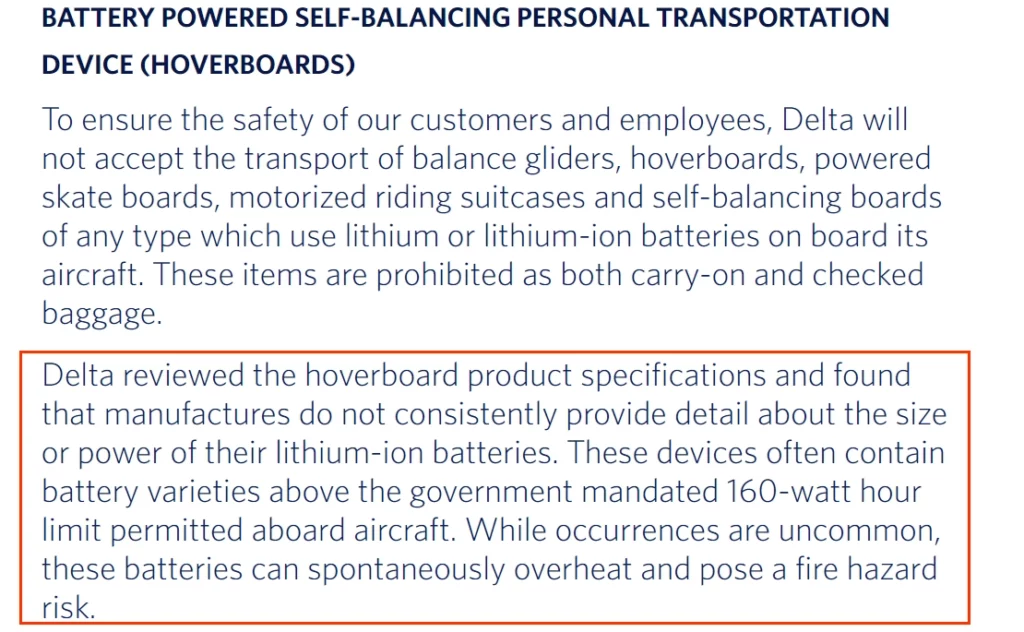
Can you bring an electric scooter on a Southwest flight?
Southwest prohibits all self-balancing devices on board, both as checked and carry-on baggage. That means they won’t allow electric scooters.
Medical scooters and wheelchairs are exceptions.
The information is available on the Southwest special baggage and sports equipment page, under the hoverboards section.

Can you bring an electric scooter on a United Airlines flight?
United Airlines doesn’t accept any recreational electric ally-powered scooters, self-propelled or self-balancing vehicles for safety reasons. This does not include medical electric vehicles such as wheelchairs and mobility aids.
This information is available on the United Airlines dangerous baggage page.
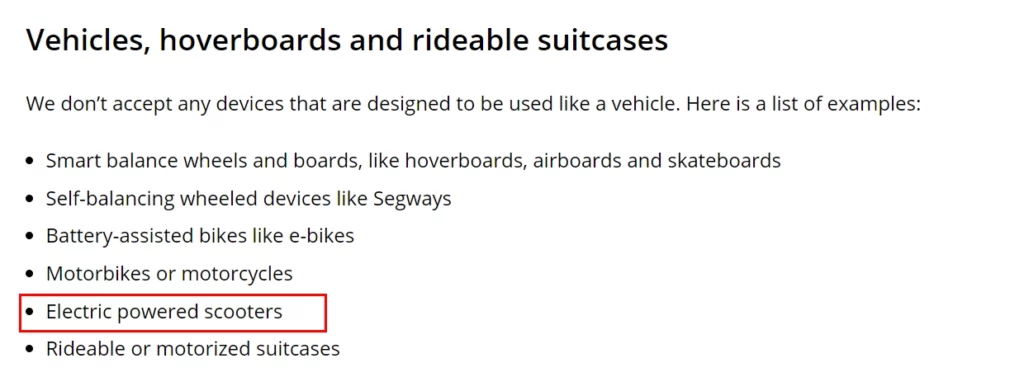
Can you bring an electric scooter on an American Airlines flight?
American Airlines doesn’t allow lithium-ion battery-powered personal transportation devices on board, neither as carry-on nor as checked-in baggage. This doesn’t include mobility aids such as electric wheelchairs, which are allowed on board.
The source of this information is the American Airlines restricted items page.
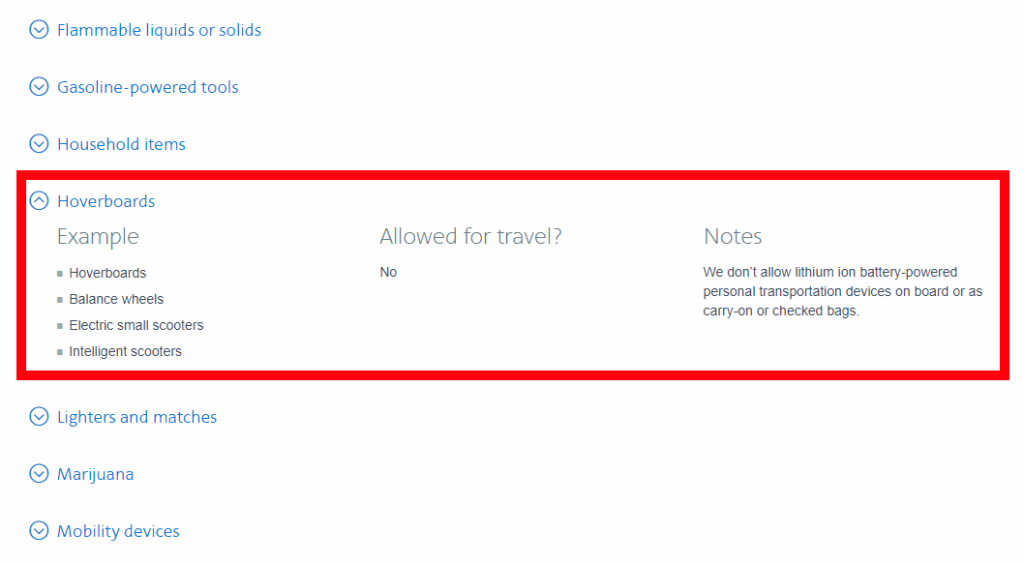
Can you bring an electric scooter on a Jet Blue flight?
Jet Blue prohibits most rideables. While electric scooters aren’t named, the ban on similar devices like balance gliders, hoverboards, electric skateboards, and self-balancing gadgets implies they might not be allowed either. Mobility aids are accepted.
The source for this information is the Jet Blue prohibited items.

Can you bring an electric scooter on Spirit Airlines flight?
Spirit Airlines does not permit electric scooters and other electric-powered vehicles on their flights due to safety concerns related to hazardous materials.
This information is available on their website.

Can you bring an electric scooter on SkyWest Airlines flight?
SkyWest Airlines’s website doesn’t offer a clear restricted items list nor mentions electric scooters, however it is noted that hoverboards are prohibited.
Additionally, if your carry-on bag is checked at the gate, you should make sure it doesn’t have dangerous items like lithium batteries. You’ll need to bring those items into the cabin with you.
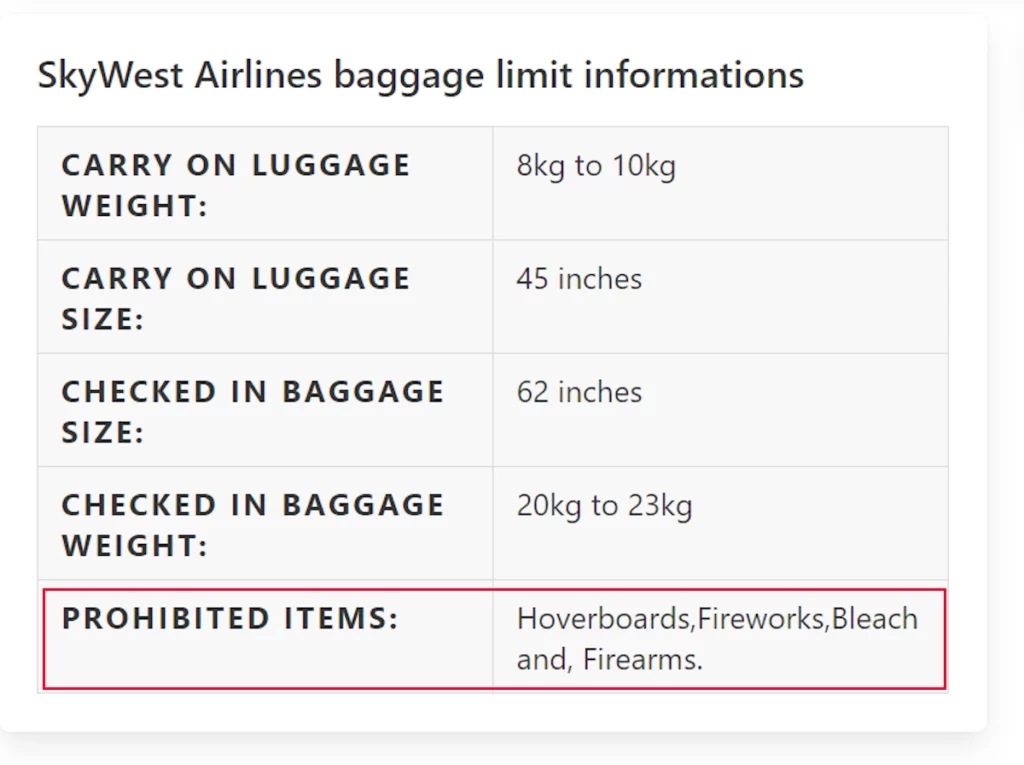
Can you bring an electric scooter on Alaska Airlines flight?
Lithium or lithium-ion battery powered self-balancing devices are not accepted on Alaska Airlines flights in either checked or carry-on baggage.
Mobility aids can, however, be transported through carry-on baggage.
This information is available on the Alaska Airlines website, within the restricted items category.

Can you bring an electric scooter on a Hawaiian Airlines flight?
Hawaiian Airlines has a strict safety policy that does not permit battery-powered self-balancing devices like hoverboards, Segways, and electric unicycles during flights.
You can find this information on Hawaiian Airlines, in the restricted items category.

Can you bring an electric scooter on PSA Airlines flight?
PSA Airlines is a subsidiary of American Airlines so the same rules and regulations apply, i.e lithium-ion battery-powered personal transportation devices are not permitted, whether as carry-on or checked baggage.
However, this policy does not apply to mobility aids like electric wheelchairs, which are allowed on board.
You can find this information on the American Airlines website, in the restricted items category.
Canadian airline rules for electric scooters
Electric scooters are not allowed on Canadian flights. Listed below for reference are the restricted items policies of the major Canadian airline companies.
| Airline | Allows electric scooters? |
|---|---|
| Air Canada | No |
| WestJet | No |
| Air Transat | No |
| Porter Airlines | No |
| Flair Airlines | No |
| Canadian North | No |
| PAL Airlines | No |
Can you bring an electric scooter on Air Canada flight?
Air Canada has a strict policy prohibiting hoverboards, AirBoards, electric skateboards, airwheels, mini-Segways, balance wheels, battery-assisted bikes and electric scooters in checked or carry-on baggage.
You can find out more on the Air Canada Airlines website, in the restricted/prohibited items category.
There is an exception regarding mobility aids (wheelchairs), which are allowed with a special handling.
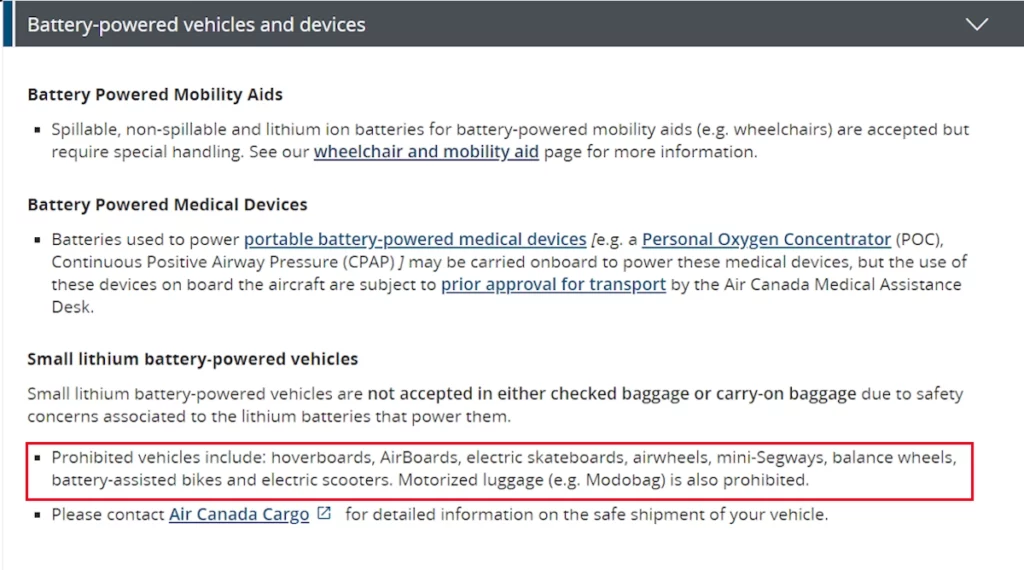
Can you bring an electric scooter on WestJet flight?
WestJet doesn’t allow hoverboards, airboards, airwheels, electric skateboards, balance wheels, mini-segways, battery assisted bikes, electric scooters, and any motorized luggage on flight.
Mobility aid devices are allowed on flight as well as one spare lithium ion battery with a maximum power of 300 Wh. If your mobility aid requires two batteries, each up to 160 Wh.
This information is available on the WestJet Airlines website.
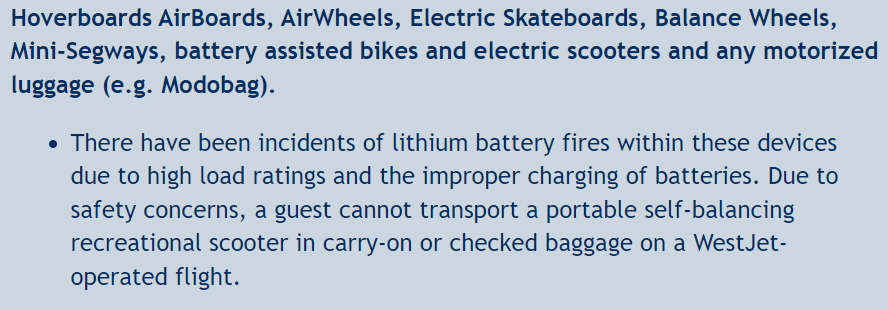
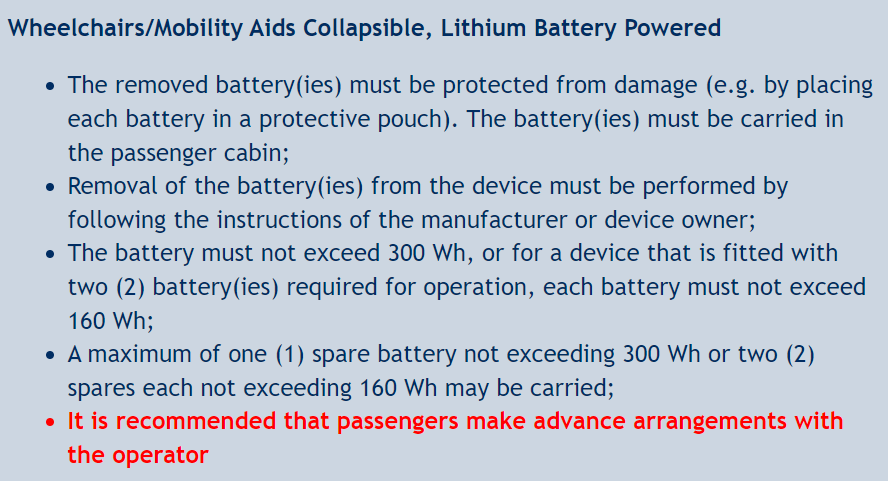
Can I bring an electric scooter on AirTransat flight?
AirTransat does not allow electrically powered vehicles. This includes items like hoverboards, electric skateboards, airwheels, Onewheels, mini-Segways, balance wheels, electric scooters like Razor scooters, road scooters, tricycles, and battery-assisted bicycles.
Even if the vehicle’s batteries are taken out, these items won’t be accepted.
The only exception to this policy is mobility aids.
You can find this information on the AirTransat Airlines website, in the restricted items category.
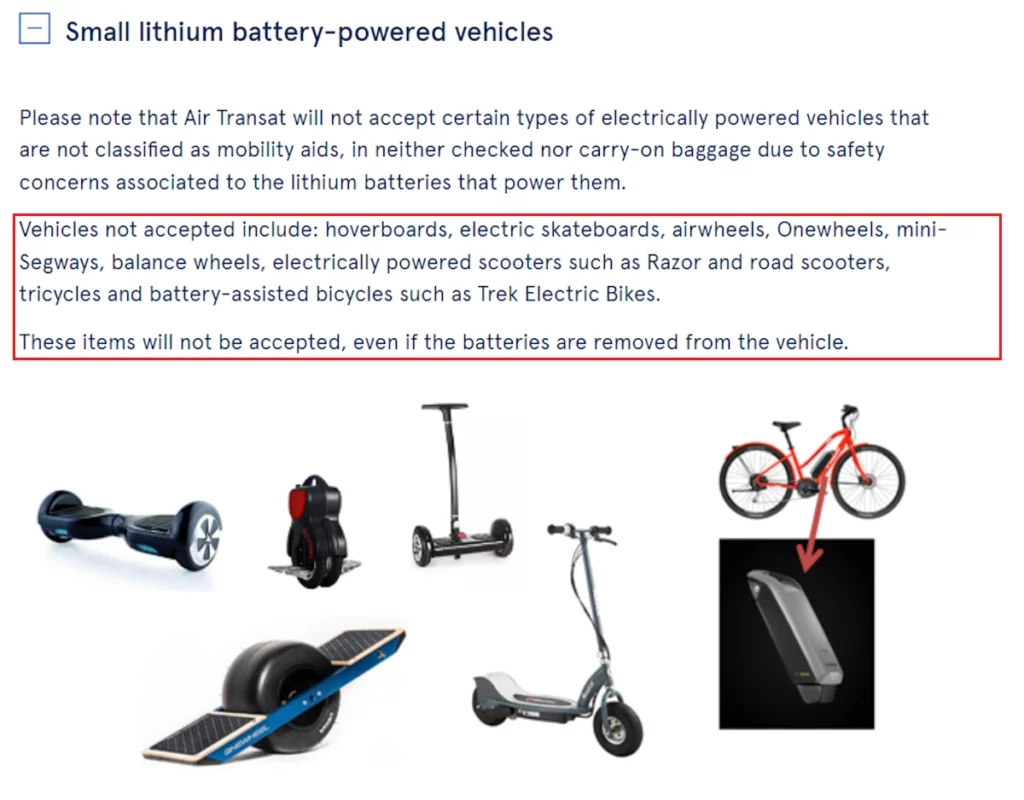
Can I bring an electric scooter on Porter Airlines flight?
Porter Airlines strictly prohibits lithium battery-operated personal transportation devices in either checked or carry-on baggage, referencing electric scooters in their restricted items list.
The source of this information is the Porter Airlines restricted and prohibited items policy.
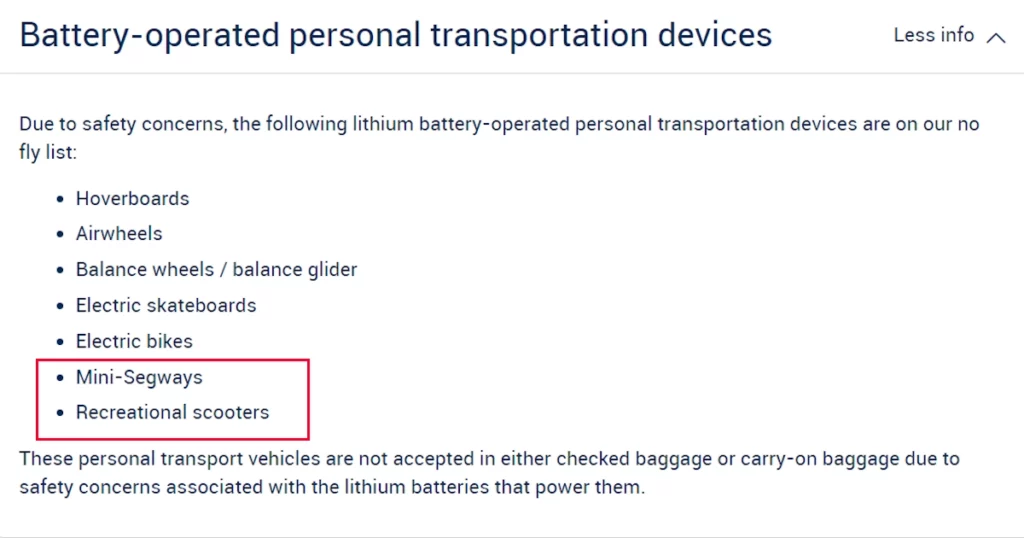
Can I bring an electric scooter on Flair Airlines flight?
Flair Airlines doesn’t allow battery-powered vehicles and devices i.e electric scooters on flight, due to incidents of lithium battery fires contained by the devices.
Mobility aids are an exception, but in those cases, the battery removed from the device must be protected from damage and kept in the passenger cabin.
This information is available on the Flair Airlines website, on the restricted items page.
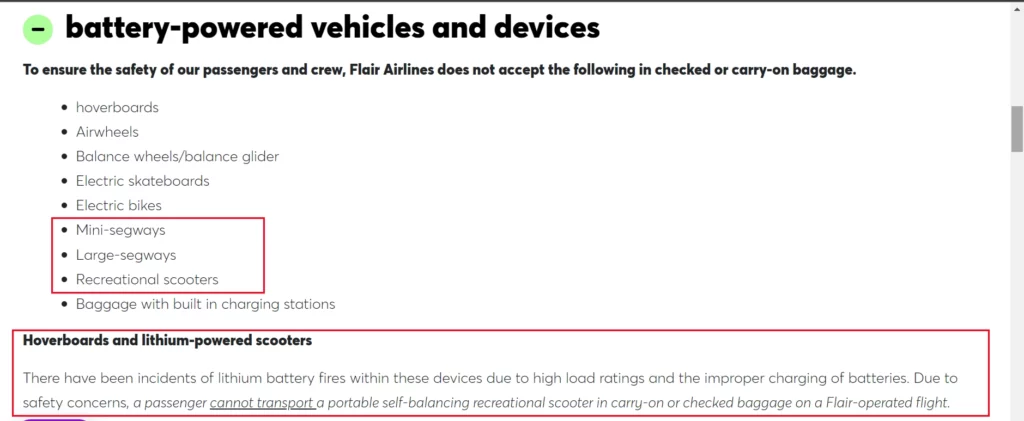
Can I bring an electric scooter on Canadian North flight?
Canadian North Airlines prohibits electric scooters on flight, in either checked or carry-on baggage.
However, you can contact a carrier from their airline services and ask about a transportation option like cargo.
You can find this information on the Canadian North Airlines website, in the baggage information category.
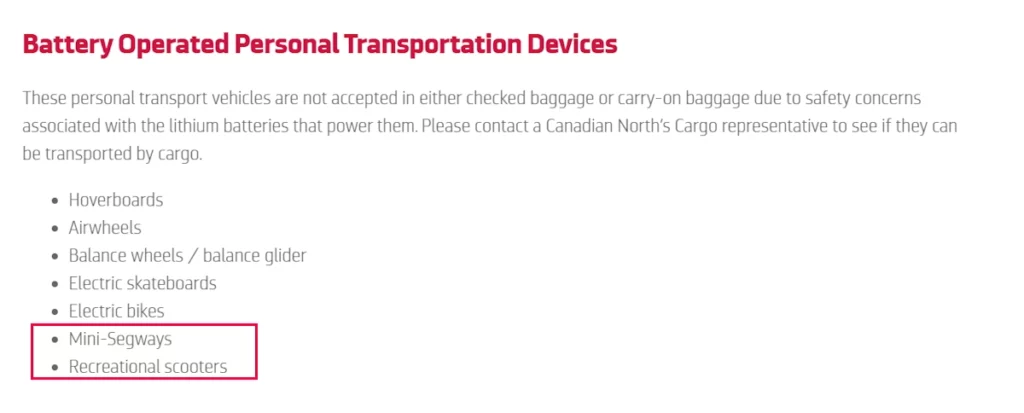
Can you bring an electric scooter on PAL Airlines flight?
According to CATSA, PAL Airlines does not have a clear policy about electric scooters.
Lithium batteries exceeding 160 Wh, as well as hoverboards, can be accepted with a previous consultation with the air carrier.
You can find out more information on CATSA’s website.

TSA rules about electric scooters on planes
In short, TSA rules don’t strictly prohibit electric scooters on US flights. However, their policies indicate that most of the widely-used electric scooters today will not be allowed on the flight, neither in checked nor in carry-on baggage.
The TSA (Transportation Security Administration) is a US government agency responsible for ensuring the security of transportation systems, including airports, and protecting travelers from threats. They screen passengers and their belongings at airports, and implement security measures throughout the transportation sector.
The TSA doesn’t have a specific policy on electric scooters.
However, they do have a policy on hoverboards, which are devices that belong in the same category as electric scooters. The TSA instructs checking in with the airline on whether you can take a hoverboard on board (both in checked and carry-on baggage).
Another potentially relevant set of rules is TSA’s policies on battery-powered wheelchairs and mobility devices, which state the following:
- Spillable batteries for mobility devices are allowed if securely attached, protected from damage, and positioned upright on the aircraft.
- Non-spillable batteries may require specific measures.
- Lithium ion batteries must be removed, protected, and carried in carry-on baggage, with airline and pilot notification.
So, the TSA allows mobility devices with lithium batteries on board, but that only applies to people with mobility issues.
Possibly TSA’s most relevant policy for electric scooters is the policy on lithium batteries bigger than 100 Watt-hours:
- They are allowed in carry-on baggage, but with special instructions
- They are not allowed in checked baggage
- Spare lithium batteries over 100 Wh must be in carry-on baggage.
- With airline approval, up to two larger lithium ion batteries (101–160 Wh) are allowed.
- One person can bring a maximum of two larger lithium ion spare batteries.
FAA rules about electric scooters on planes
Bottom line up front, the FAA doesn’t specifically mention electric scooters in its policies. It has several policies that may apply for electric scooters, such as the policies on portable electronic devices, lithium ion batteries, and electric wheelcharirs and mobility scooters. However, the FAA neither allows nor prohibits electric scooters on board, specifically.
The FAA (Federal Aviation Administration) is the United States government agency responsible for regulating and overseeing civil aviation to ensure safety and efficiency. The rules and regulations set by the FAA are mandatory for airlines operating within the United States and for any airline that flies into or out of US airspace.
According to FAA’s PackSafe policies for electric wheelchairs and mobility scooters:
- Lithium Ion Batteries – Not Adequately Protected and Batteries Removed:
- Lithium ion battery size limited to 300 Wh.
- One spare battery under 300 Wh or two under 160 Wh each in carry-on.
- Lithium metal batteries not allowed.
- Batteries must be removed and protected when not adequately housed.
- Contact airline for passenger instructions. May be checked.
- Lithium Ion Batteries – Installed and Protected:
- Battery may remain installed if securely attached, protected, and cables secured.
- One spare battery under 300 Wh or two under 160 Wh each allowed.
- Lithium metal batteries not allowed.
- Contact airline for passenger instructions. May be carried in cabin.
- Non-Spillable or Dry Batteries:
- Battery may remain if securely attached and protected.
- Battery cables can stay if the device is secured.
- Max one spare battery per passenger as per airline instructions.
- Spillable Batteries:
- Battery may remain if securely attached and protected, upright.
- Contact airline for passenger instructions. May require extra arrangements.
Furthermore, according to FAA PackSafe policies on lithium batteries, additional rules apply. Lithium batteries may overheat, leading to thermal runaway, and thus require safety testing. They should be carried in carry-on baggage only. Spare lithium batteries must be in carry-on, with terminals protected. The size limit for lithium-ion batteries is 100 Wh. Larger lithium ion batteries (101–160 Wh) are allowed with airline approval. There are no specific quantity limits for personal use, but spare batteries for sale are prohibited. Batteries must be protected from damage and short circuit. Damaged or recalled batteries should not be transported.
FAA policies don’t specifically mention electric scooters. However, the majority of electric scooters in use today have batteries that are much bigger than FAA’s battery limit of 160 Watt-hours.
In summary, while the FAA doesn’t directly prohibit electric scooters on flights, its policies strongly suggest that most electric scooters will not be allowed on board.
IATA rules about electric scooters on planes
The IATA (International Air Transport Association) is a global trade organization representing airlines. It works to standardize and improve various aspects of the airline industry, including safety, operational efficiency, and passenger experience.
North American airlines are members of IATA, so they follow its guidelines and are affected by its policies and regulations.
There are several IATA policies that are relevant to bringing electric scooters on board:
Based on these policies:
- You are allowed to bring devices with lithium batteries on board if they don’t exceed 100 Watt-hours.
- You can even bring batteries of up to 160 Watt-hours, but you need a special permission from the airline.
- You can carry the batteries in both checked-in and carry-on baggage.
CATSA rules about electric scooters on plane
Similarly to FAA, CATSA does not directly prohibit electric scooters. However, there is a battery guideline which mentions electric scooters and the possibility of allowing in-device battery under 160 Wh with an air carrier approval.
CATSA, which stands for the Canadian Air Transport Security Authority, is a Canadian government agency responsible for aviation security in Canada. Its main mission is to ensure the safety and security of air travel within the country.
Based on their policies:
- For lithium ion batteries with a rating of 100 Wh or less, you can bring them in either carry-on or checked baggage, but again, make sure to check with your airline for any specific requirements, especially for spare batteries.
- If you have lithium ion batteries in a device with a rating between 100-160 Wh, you can typically bring them in your carry-on baggage or checked baggage, but it’s essential to check with your airline for approval. For spare lithium ion batteries in the 100-160 Wh range, you can carry up to two of them in your carry-on baggage with airline approval, while they’re allowed in checked baggage only with the airline’s consent.
- You can carry a lithium battery to operate a mobility device, such as a mobility wheelchair or scooter, along with one spare battery of up to 300 Wh at the checkpoint.
Airplane rules for popular electric scooters
Most electric scooters for adults today won’t be allowed on board by the major North American airlines. My guide on the airline-approved electric scooters has a bit more information about some possible exceptions.
Here’s a quick overview on the whether you can take the most popular electric scooters on your flight.
Can you bring Xiaomi M365 Pro on a plane?
You can’t take the Xiaomi M365 Pro on a plane. The scooter has a 474 Wh battery, which exceeds the maximum battery limit of 160 Wh. No airline in North America will allow you to take a battery of that capacity on the plane, neither in checked nor in carry-on baggage.
Can you bring the Xiaomi M365 electric scooter on a plane?
The Xiaomi M365 will not be allowed on a flight in North America. It has a 280 Wh battery, which is more than what airlines and flight organizations permit.
A potential workaround for the Xiaomi M365 with specific airlines is discussed bellow.
Can you bring the Ninebot ES2 electric scooter on a plane?
The Ninebot ES2 will not be allowed on a plane. It has a battery capacity of 187 Wh, which is slightly above the airline battery limit of 160 Wh.
Can you bring a Segway on a plane?
You can’t bring a Segway on a flight. Even the smallest Segways with the lowest battery capacities still have batteries of 236 Watt-hours, which is over the allowed limit.
Can you bring a Razor electric scooter on a plane?
There might be a few scenarios in which you might bring certain Razor models on board. The Razor E-Prime has a battery capacity of 115.2 Wh, while the Razor Ecosmart has 108 Wh, and both of those batteries might be allowed on a plane if you can get a special permission from the airline. However, that will only apply to airlines that don’t strictly prohibit self-balancing devices on board, and there are not that many of those in the US and Canada.
So, even though some Razor models have batteries that don’t break baggage policies, they will still not be allowed on board in most cases.
How to find out if your scooter is allowed on an airplane
From my experience, the most straightforward and reliable method is to speak directly with airline personnel to determine if you can bring your scooter. This approach is recommended to avoid potential stress and incorrect information.
When discussing your scooter, be sure to clarify that it’s not a mobility device.
Determine your electric scooter battery size
It’s best if you start with your scooter’s battery storage, since this will almost always be a limiting factor.
Your scooter’s manual often has this info. If you can’t find it, just search your scooter’s model with these keywords:
- battery specs
- battery energy storage
- specs
- user manual (look for the specs, and then look into the “battery” section)
You will often find the battery’s energy storage expressed clearly in watt hours (Wh).

You can also locate the battery’s voltage (in V) and capacity (in Ah). Just multiply the capacity (Ah) by the voltage (V).
1 V * 1 Ah = 1 Wh
Voltage times capacity equals energy storage
How can I transport my electric scooter?
For nearby destinations, explore alternative transportation like trains, which have no restrictions on electric scooters.
If you must transport your scooter and can’t find a suitable airline, consider sending it via cargo plane or a delivery service. Pack it as a fragile item, following the earlier instructions.
Remember that many cities now offer scooter rental services such as Lime and Bird, making it convenient for shorter trips.
FAQs
Electric scooters are not allowed in neither checked nor carry-on baggage.
Most airlines cap electric scooter batteries at 160 Watt-hours (Wh). Batteries exceeding this limit are typically not allowed. Smaller batteries under 100 Wh are usually permitted.
To determine your scooter’s battery size, refer to the manual, which often lists the battery’s energy storage in Watt-hours (Wh). If the manual is unavailable, search your scooter’s model online using relevant keywords.
Some airlines allow two batteries totaling up to 300 Wh, while others permit individual batteries up to 160 Wh. If your scooter’s battery capacity falls between these ranges, splitting the battery is a potential solution.
If your airline allows your electric scooter, you’ll likely need to check it as separate luggage, label it, remove the battery for your carry-on, and follow packing guidelines, while being prepared for extra fees. Typically, carrying it as carry-on luggage is unlikely due to its size.


